How to Install M.2 SSD [Beginner's Guide⭐]
In the modern age, computers need to be quick and efficient. People want fast data retrieval, seamless multitasking, and speedy application launches. Technology is keeping up with these demands, and one solution for Windows users is to install a reliable SSD to enhance their system's performance. In this guide, Qiling will provide a detailed explanation and tutorial on installing an M.2 SSD. Additionally, we will discuss the advantages of installing an M.2 SSD. So, follow and read this short guide entirely.
Share this post on your social platforms to help people who want to install M.2 SSD to enhance the performance of their computers:
How to Install M.2 SSD: Step-by-step Tutorial
It's good to know that before buying an M.2 SSD, ensure your motherboard supports it. Most recent motherboards do, but if your PC is a few years old, you might need to stick with traditional SSDs. Check your motherboard's manual or look up your model online to confirm compatibility.
Look for an M.2 slot, a small raised connector resembling a skinny cable port. It's distinct and easy to spot. Once you confirm your PC or laptop has an M.2 slot, install an M.2 SSD on your Windows PC. We'll explore how to do this without formatting your C drive in Windows 7. Here's a short brief of what you'll need to prepare in advance:
Preparation for Installing M.2 SSD
Before you start the installation process, prepare the following items:
- Your Windows computer.
- The screwdriver is set to unscrew.
- The M.2 SSD that you want to install.
- A smartphone or another device to access additional instructions (if needed).
- Qiling Disk Master is a powerful and user-friendly partitioning tool that will make the process easier.
Phase 1. Install the M.2 SSD
Once you prepare all the necessary tools and resources, you must install SSD on your PC. In this phase, we'll learn how to physically install/insert your M.2 SSD on your computer or laptop.
Follow the steps:
Step 1. Disconnect your PC from the power source and open the case. Unscrew the side of your case to access the motherboard.
Step 2. Find M.2 slot. M.2 slot may be behind your GPU, as mine is on the Z490 Unify.
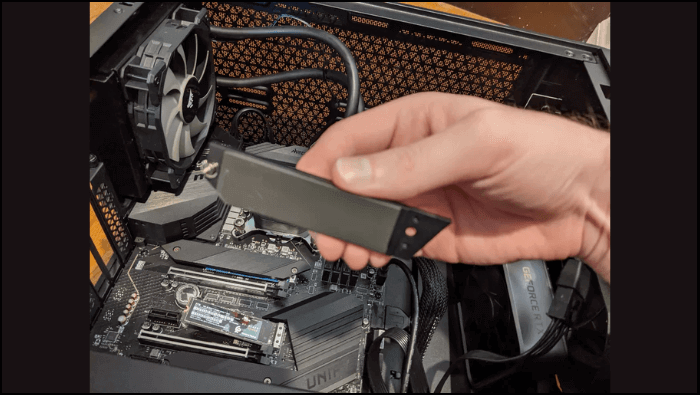
Step 3. Remove one if the motherboard has integrated heatsinks before installing an M.2 SSD. Unscrew it and set it aside temporarily.
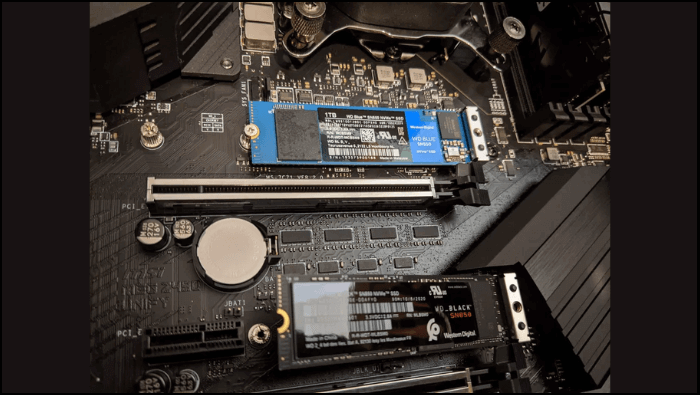
Step 4. Locate your M.2 SSD slot, remove the screw, and insert the SSD diagonally.
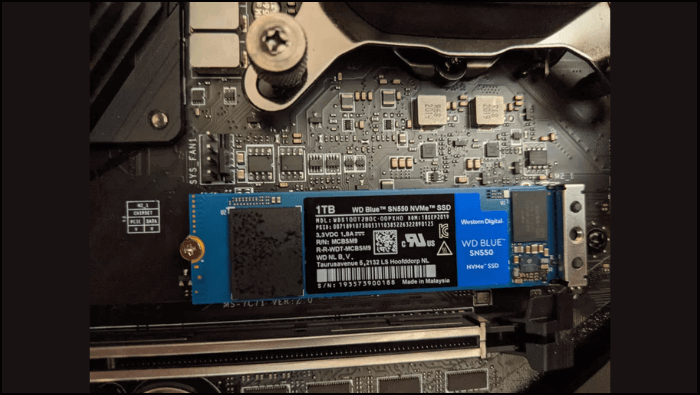
Step 5. Screw it back in, using it to secure the M.2 SSD in place. The M.2 drive has a small semicircular hole, so you'll see exactly where the screw goes.
Step 6. Once physical installation is done, reassemble hardware parts.
Phase 2. Initialize the M.2 SSD
It must be initialized to ensure the proper functionality of your M.2 SSD drive. We recommend using Qiling Disk Master Pro for simplified initialization. This software offers a variety of functions that can streamline the initialization process and enhance your overall SSD management experience.
Advantages of Qiling Disk Master:
Compared to other methods, Qiling Disk Master offers several advantages:
- User-friendly interface
- Safe and risk-free
- Time-saving operation
- Comprehensive features
Let's explore using Qiling Disk Master to initialize your M.2 SSD efficiently and effectively.
Follow the steps:
Step 1. Open Qiling Disk Master and got to Partition Manager.
Step 2. Right-click the target disk - HDD or SSD and select "Initialize to MBR" or "Initialize to GPT".
Features of Qiling Disk Master:
- Resize/Move partitions without data loss.
- Clone your OS and migrate to another drive or PC.
- Format the disk to another file system like NTFS.
- Merge partitions into one.
- Wipe data on your hard drives.
Download this all-featured tool and make your disk management more effective:
Bonus Tip: How to Partition a New M.2 SSD?
While initializing the SSD ensures your system recognizes it, partitioning allows you to create separate storage areas for different purposes, optimizing organization and data management.
For this purpose, you can also use Qiling Disk Master. It excels in SSD initialization and offers a user-friendly method for creating, resizing, and managing partitions on your new M.2 SSD.
Follow the steps:
Step 1. Open Qiling Disk Master, go to Partition Manager and right-click the empty disk and choose "Create" menu.
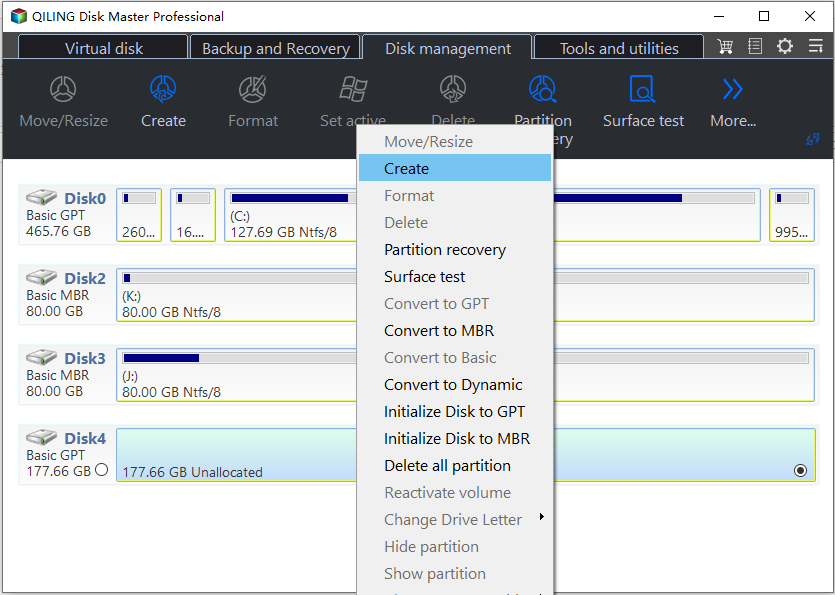
Step 2. Set the number of partitions you need to create, and set the partition style to your disk - MBR or GPT.
Or, you can accept the default setting offered by Qiling Disk Master. Once done, click "Proceed".
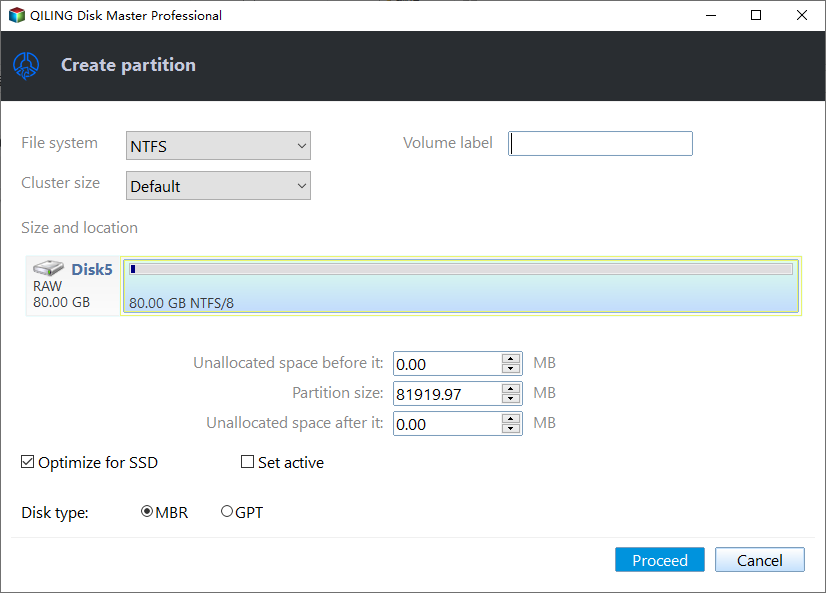
Step 3. Waiting to finalize partitioning the new HDD/SSD or external disk.
If your computer encounters any startup problem after installing the M.2 SSD, you can refer to the tutorial below to fix it:

How to Fix PC Won't Boot After Installing M2 SSD
This article covers why the PC won't boot after installing the M.2 SSD and provides multiple solid solutions to help you fix the issue.
Benefits of Installing a M.2 SSD
Installing an M.2 SSD is a desirable and suitable option for many users, thanks to the reliability of the M.2 SSD performance. Because they offer numerous benefits, such as ample storage capacity and faster speed than traditional hard drives.
Let's explore the significant benefits of an M.2 SSD:
📟Larger Storage: It provides ample storage capacity and allows for storing heavy data, large multimedia files, and applications.
💎Enhanced Performance: It offers faster read and write speeds, your applications load quickly, and your PC or laptop works fast.
🧲Faster Speed: M.2 SSDs provide lightning-fast data transfer speeds, reducing load times for software, improving boot times, and enhancing your computing experience.
🎗️Competitive Price: Despite their outstanding performance, M.2 SSDs are competitively priced and affordable.
These advantages make M.2 SSDs appealing to those looking to boost their system's capabilities.
Conclusion
Adopting an M.2 SSD upgrade is a wise decision to reach a new level of computing performance. You'll enjoy the fantastic benefits of enhanced speed, efficiency, and an expansive storage capacity. To make this process even more accessible, we highly recommend you use Qiling Disk Master. This software simplifies the installation process and authorizes you with efficient SSD management.
So, don't hesitate to embark on this transformative journey. Upgrade your laptop/computer with an M.2 SSD and discover the incredible improvements in your computing experience. With Qiling Disk Master by your side, this transition has never been more accessible or rewarding. Elevate your computing capabilities today!
FAQs About How to Install M.2 SSD
If you have more queries about how to install M.2 SSD, figure out the desired answer from the FAQs below.
1. Why does the BIOS not recognize my M.2 SSD?
There are a few reasons why your BIOS cannot recognize your M.2 SSD:
- The M.2 SSD is incompatible with your motherboard
- The M.2 SSD is not installed correctly
- The BIOS is not configured correctly
2. How to Fix M.2 SSD not showing up?
If M.2 SSD is not showing up in your BIOS, here are a few fixes you will have to try:
- Ensure that the M.2 SSD is installed correctly.
- Enable M.2 support in the BIOS.
- Update your BIOS.
- Check the compatibility of your M.2 SSD with your motherboard.
Click the following article to learn more details about the instructions:
3. How can I enable M.2 SSD in BIOS?
You can enable M.2 support in your BIOS by following these steps:
Step 1. Restart your PC/laptop and enter the BIOS.
Step 2. Use the BIOS navigation keys to locate the "SATA Configuration" or "Storage" menu.
Step 3. Find the setting for M.2 support and enable it.
Step 4. Save your changes and exit the BIOS.
Related Articles
- MBR2GPT Conversion Failed? What if MBR2GPT Validation Failed?
- Slow Boot Time! SSD Taking Long Time to Boot in Windows 11/10
- 4TB Hard Drive Only Shows 2TB Windows 11/10, Restore to the Full Capacity